Employee performance management remains one of the most critical yet challenging tasks for managers striving to maintain business excellence. A structured Performance Improvement Plan (PIP) ensures employees are given clear expectations, measurable goals, and actionable steps to improve their contributions effectively.
Despite their importance, PIPs often fail due to challenges like vague objectives, ineffective communication, and the inability to track progress efficiently. Managers with the right tools may find it easier to ensure success by providing support and accountability.
A report by the Brookings Institution revealed that many companies in the Philippines face performance management issues caused by inefficient data handling and weak development plans. This underscores the importance of adopting automated solutions that provide clarity, real-time progress tracking, and actionable feedback.
In this article, we’ll guide you through the 10 Best Performance Improvement Plan Template and powerful HRM software designed to streamline the PIP process. Discover how these tools can help your organization address performance challenges, track progress, and achieve tangible results.
Table of Content
Content Lists

Key Takeaways
|
What is a Performance Improvement Plan?
A Performance Improvement Plan (PIP) is a structured tool designed to identify and address an employee’s performance challenges while outlining growth opportunities. It specifies productivity shortfalls, skill gaps, behavioural concerns, and clear goals and deadlines.
These plans empower employees to overcome performance barriers by providing actionable steps and measurable outcomes, fostering overall growth and accountability. While often used for underperforming employees, PIPs can also serve ambitious individuals aiming for promotions by setting actionable benchmarks.
By clearly defining expectations and offering a roadmap to improvement, PIPs ensure employees can address their deficiencies with clarity and support. Additionally, competency management software can be integrated to track progress, measure skill development, and align growth efforts with organizational goals.
However, if goals are not met within the specified timeline, further actions, including termination, may result, emphasizing the importance of meeting the outlined objectives.
What is the purpose of a Performance Improvement Plan?

A Performance Improvement Plan (PIP) is a structured framework to help employees enhance their performance and align with company objectives. By integrating tools like Workday Integration, organizations can streamline performance tracking, providing employees with actionable insights and resources to meet expectations effectively.
The primary purpose of a PIP is to proactively address performance gaps while fostering a culture of accountability and continuous improvement. Managers typically introduce a PIP in response to recurring issues, such as poor time management or unprofessional behaviour, observed over the past three months.
Clarity is crucial to an effective PIP. Objectives must be clearly defined and measurable to eliminate ambiguity for managers and employees. By incorporating industry-specific best practices—such as SPSS techniques for data roles—PIPs provide employees with targeted guidance tailored to their roles.
Moreover, personalization is key to a successful PIP, as every employee’s challenges and strengths are unique. While templates provide a practical starting point, a PIP should be customized to address specific performance concerns, ensuring it delivers meaningful and lasting results.
Elements of a Performance Improvement Plan

A Performance Improvement Plan (PIP) consists of several critical elements ensuring clarity and accountability for employees and managers. These elements provide a structured framework for addressing performance issues while setting measurable objectives for improvement.
Key Elements of a Performance Improvement Plan template:
- Reason for the PIP: Clearly state why the PIP is needed, outlining the company’s performance expectations and how underperformance affects the business. This provides context and sets the tone for the employee to understand the importance of improvement.
- Identification of Problems: List the specific performance issues supported by examples and evidence to avoid misunderstandings. For instance, mention missed deadlines, task errors, or unprofessional behaviour.
- Measurable Objectives: Define clear and measurable goals for employees to achieve, ensuring they know exactly what is expected. Include resources such as training, mentoring, or regular supervisor meetings to support their improvement journey.
- Timeline and Deadlines: Specify the employee’s schedule, including milestones and a final deadline to resolve the identified issues. This creates a sense of urgency while keeping progress on track.
- Consequences of Not Meeting Expectations: Outline the potential outcomes if the employee fails to meet the PIP requirements. To emphasize the seriousness of the plan, these consequences include further disciplinary action, demotion, or termination.
By incorporating these elements into a PIP and leveraging performance management tools, organizations can create a clear path for employees to address their performance gaps and contribute effectively to the business.

10 Performance Improvement Plan Template
A Performance Improvement Plan Template is a structured document that helps managers address specific employee performance issues while providing a clear path for improvement. Below are key performance issues that managers often encounter:
1. Performance Issue: Low Work Output
Employees failing to meet their work output expectations can disrupt team productivity and project timelines. A PIP for low work output should focus on identifying root causes, setting achievable targets, and providing resources to help employees increase their efficiency.
Low Work Output
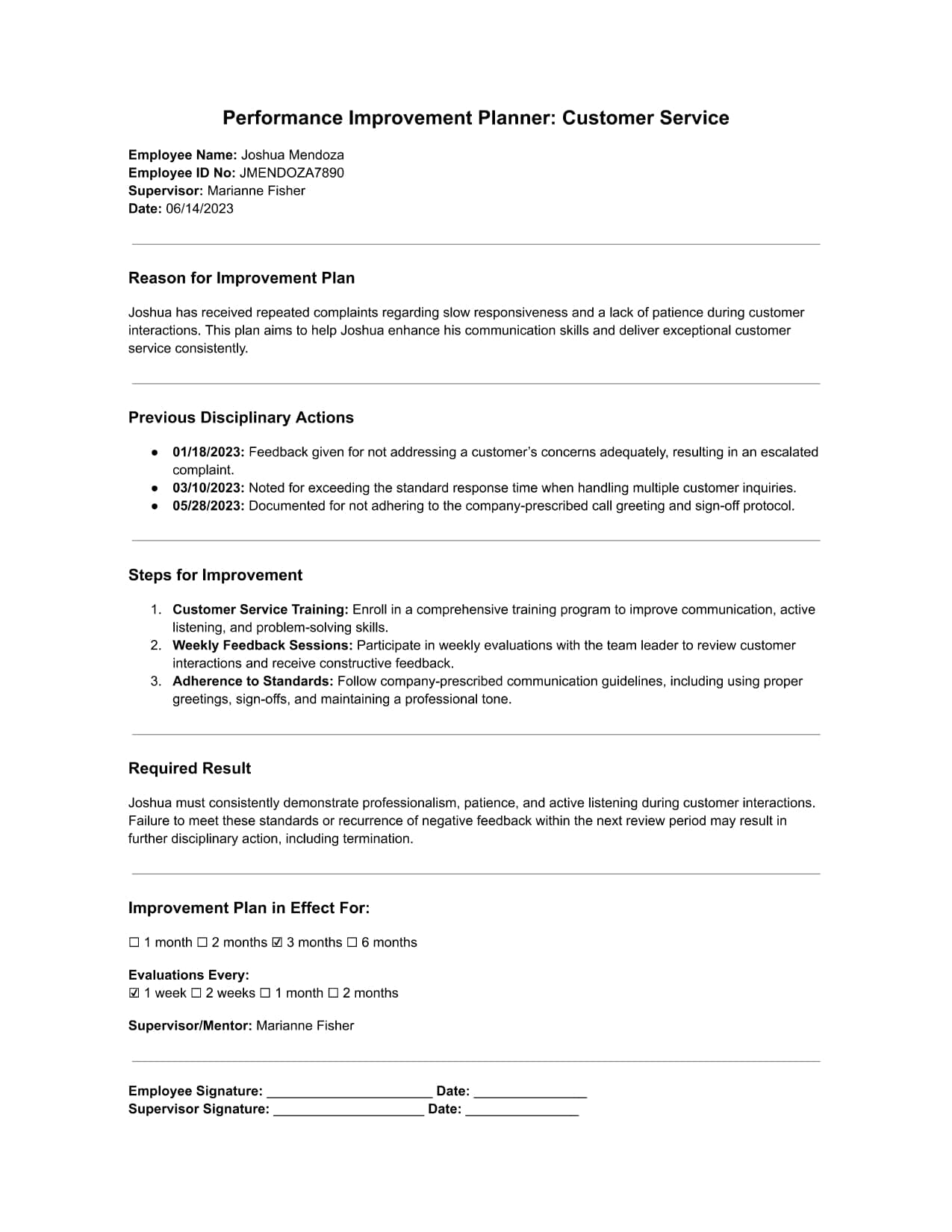

2. Performance Issue: Poor Quality of Work
Consistently delivering work with errors or below expected standards can impact business outcomes and team performance. Addressing this issue requires defining clear quality standards, offering training, and regularly reviewing progress to ensure improvements.
Poor Work Quality
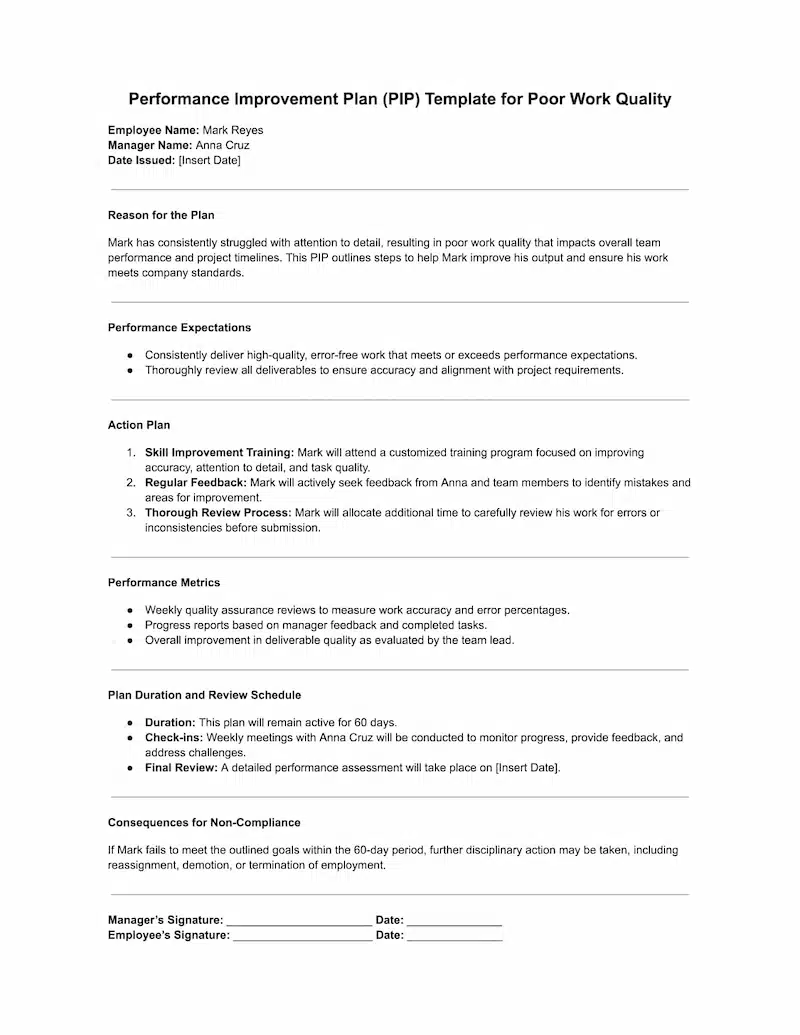

3. Performance Issue: Unprofessional Behavior
Unprofessional behavior, such as poor attitude, conflicts, or inappropriate conduct, can affect workplace morale and collaboration. A PIP for this issue should focus on setting behavioral expectations, improving communication, and encouraging professional conduct.
Unprofessional Behavior
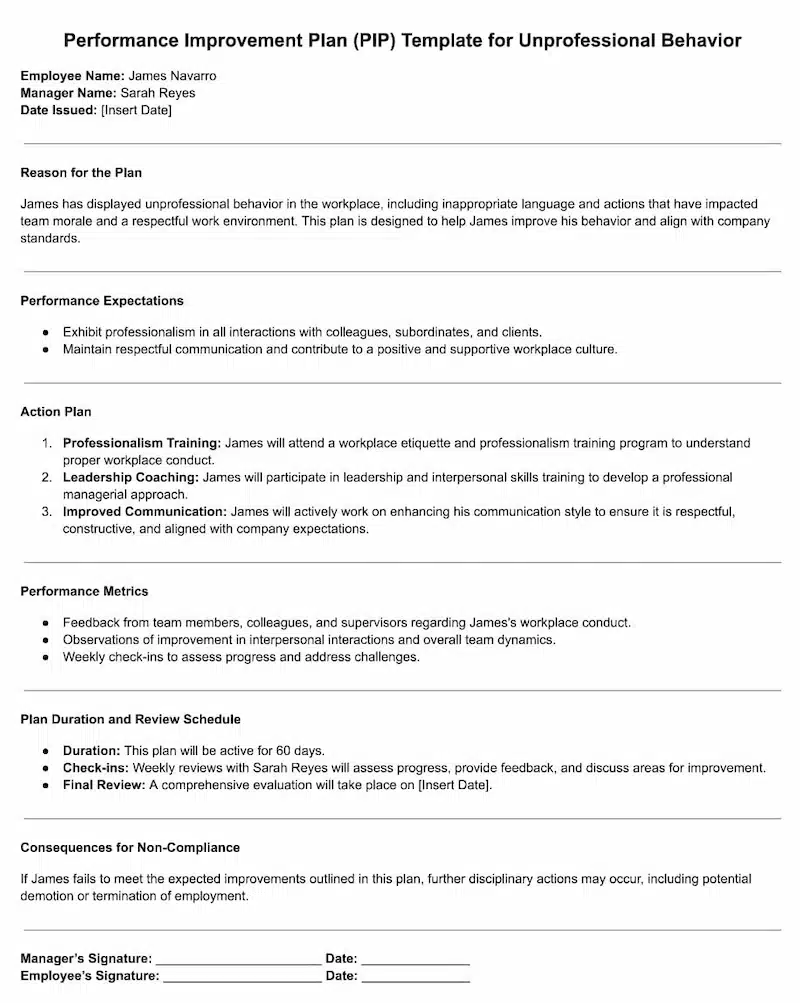

4. Performance Issue: Time Management or Missed Deadlines
Employees who need help managing their time effectively or consistently miss deadlines can delay critical projects. A strong PIP will include clear deadlines, tools for prioritizing tasks, and strategies like time-blocking or goal-setting to improve productivity.
Time Management or Missed Deadlines
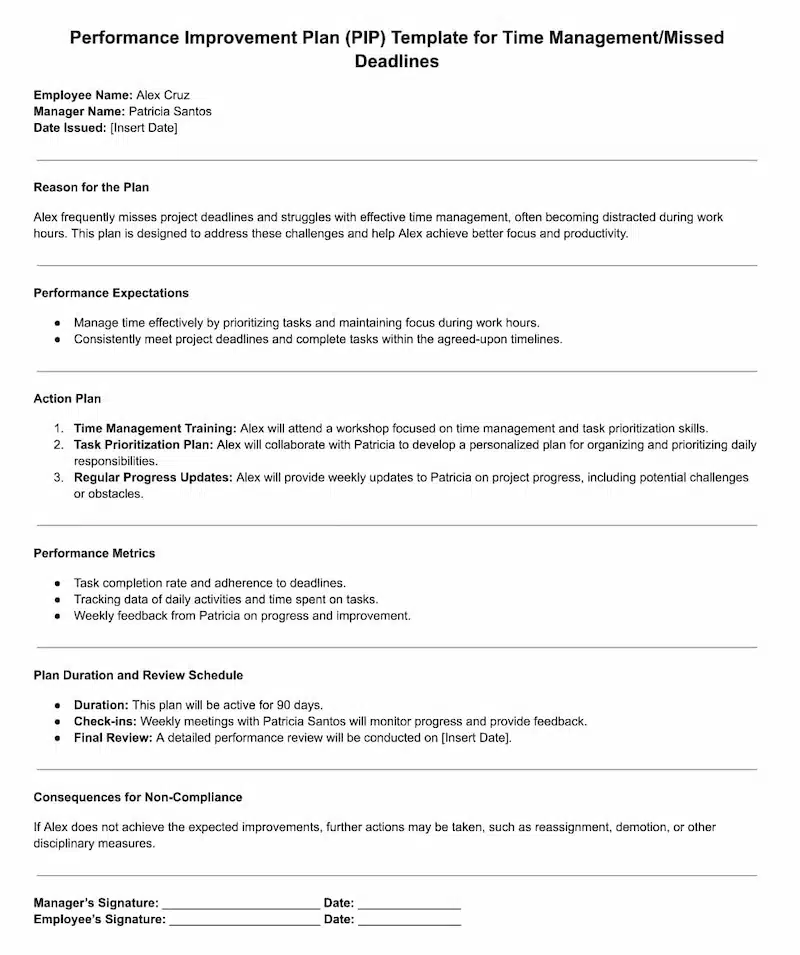

5. Performance Issue: For Employees
Sometimes, employees face multiple performance challenges, from skills gaps to lack of motivation. A comprehensive PIP should assess the issues, set specific goals, and provide mentorship or additional resources to support holistic improvement.
Performance Issue: For Employees
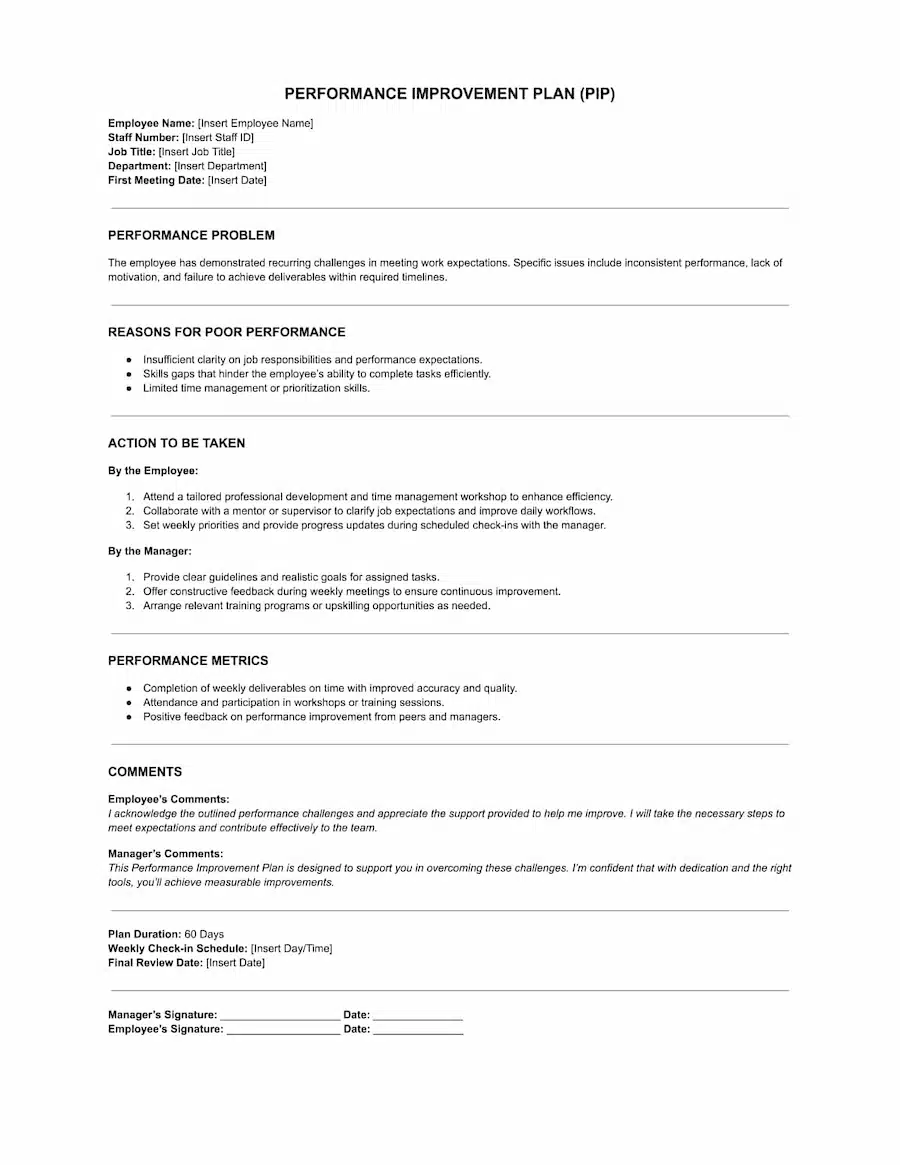

6. Performance Issue: Poor Leadership
Leadership issues, such as ineffective team management or lack of vision, can impact team performance. A PIP for poor leadership should focus on improving decision-making, delegating effectively, and enhancing leadership skills through training or coaching.
Performance Issue: Poor Leadership
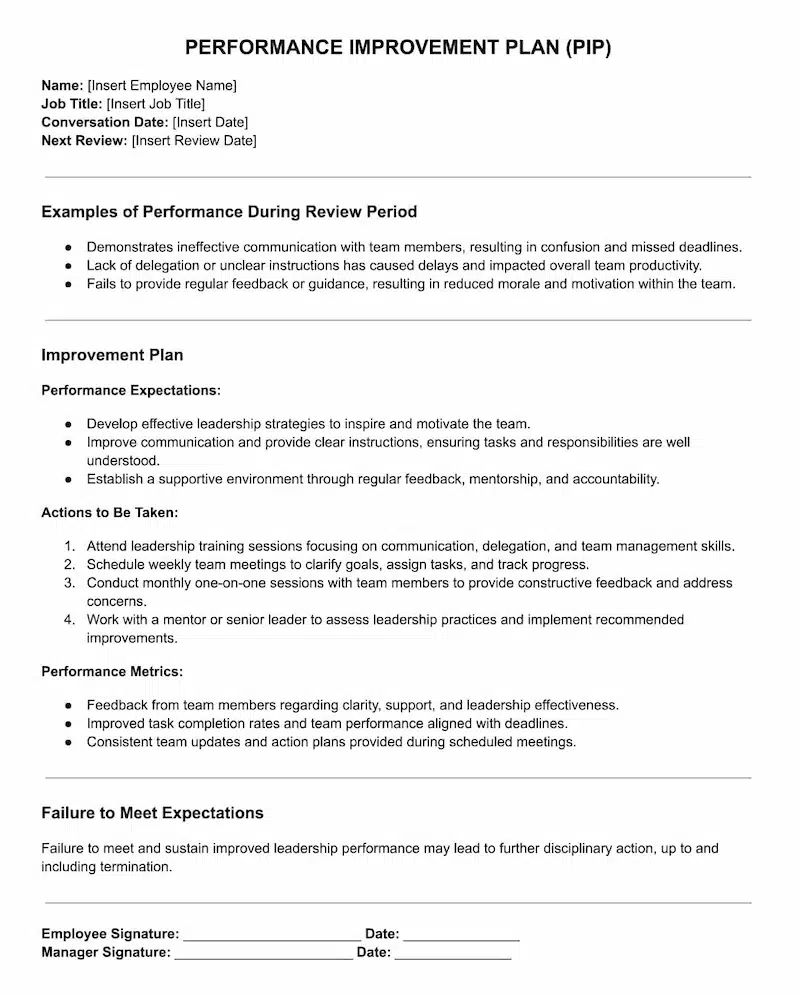

7. Performance Issue: Communication Issues
Communication can lead to better understanding, missed tasks, and team conflicts. A tailored PIP should emphasize the importance of active listening, concise messaging, and regular team updates to ensure smoother collaboration.
Performance Issue: Communication Issues


8. Performance Issue: Customer Service
Failing to meet customer service standards can damage the company’s reputation and relationships. A PIP should outline clear service expectations, provide customer engagement training, and track customer satisfaction improvements over time.
Performance Issue: Customer Service
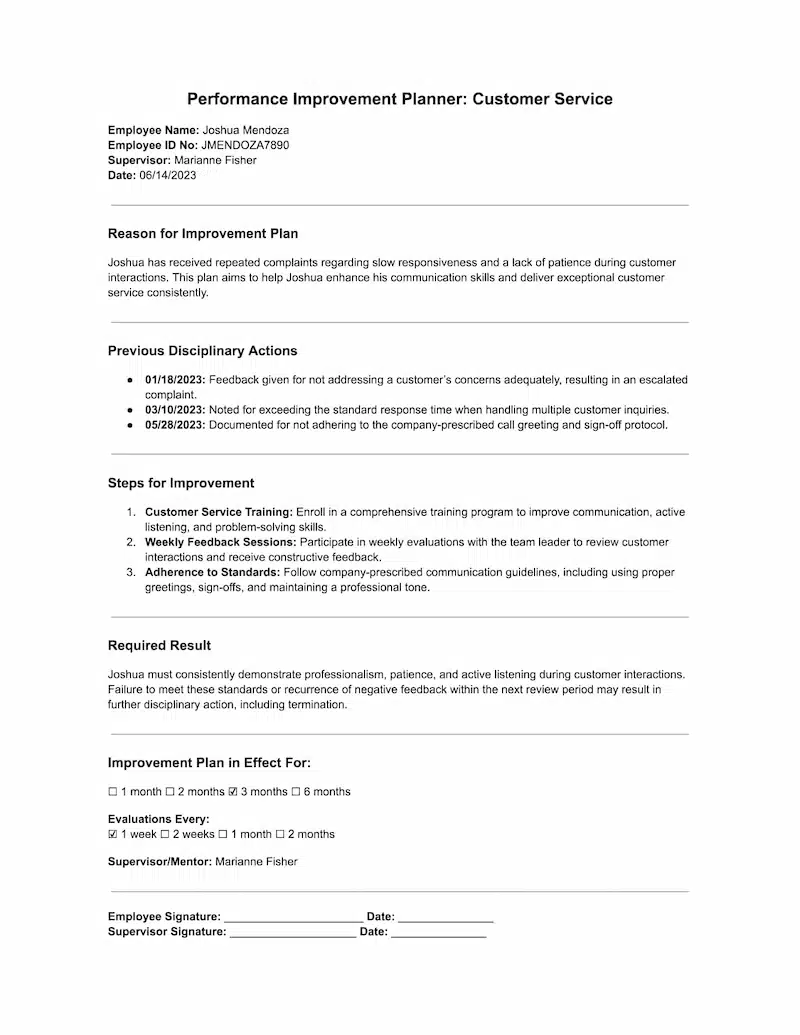

9. Sales Performance Improvement Plan Template
Sales Performance Improvement Plan
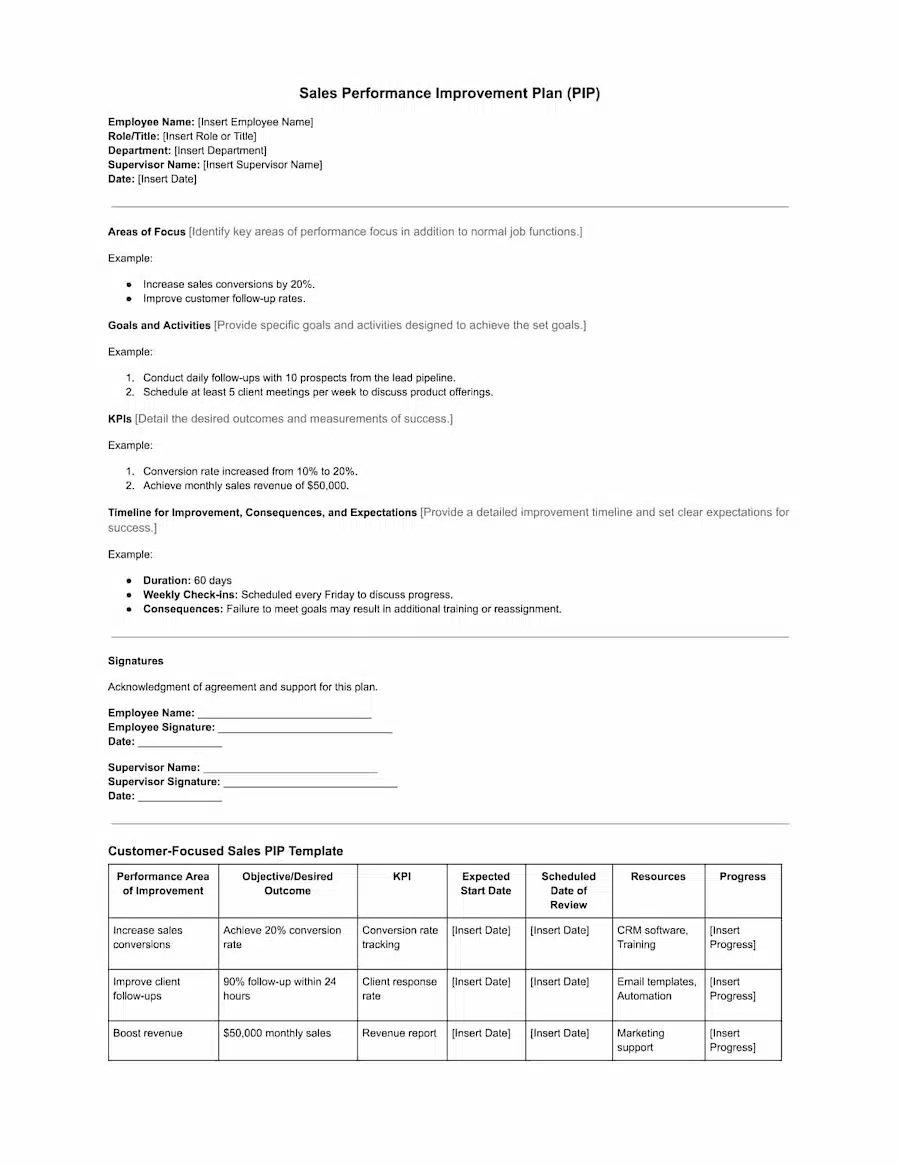

10. Sample Performance Improvement Plan Memo
Sample Performance Improvement Plan Memo
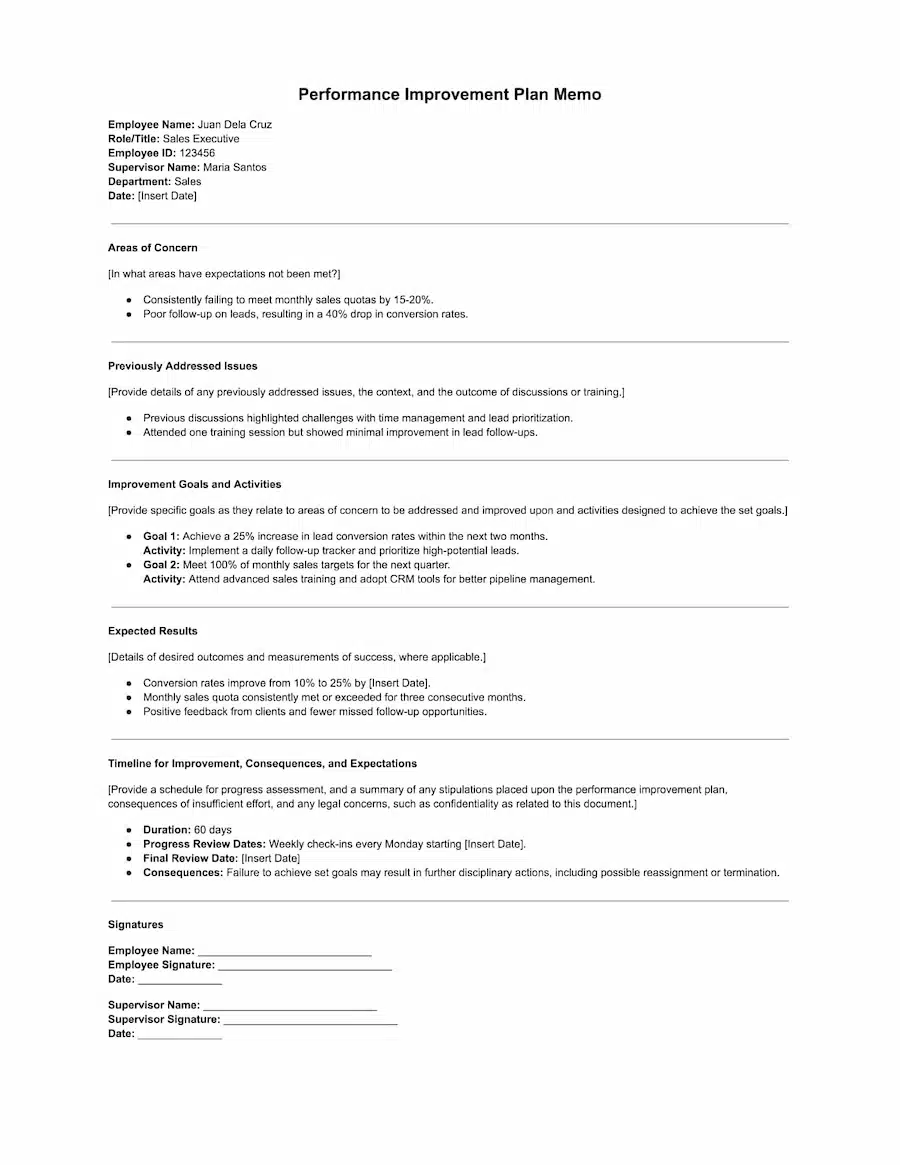

By identifying and addressing these everyday performance issues through a well-designed Performance Improvement Plan template, managers can guide employees toward improvement while fostering a more productive and positive work environment.
Creating a Performance Improvement Plan

In today’s competitive business landscape, ensuring optimal employee performance is crucial for organizational success. Addressing performance issues with clarity and purpose is vital to maintaining productivity and morale.
Crafting a Performance Improvement Plan (PIP) can be daunting, but by following a structured approach, managers can create a transparent and practical roadmap for improvement.
Below are ten essential steps to help you draft a comprehensive PIP that fosters growth and accountability.
- Identify the performance issues: The first step is pinpointing the specific performance issues affecting the employee’s role. Whether it’s data entry inaccuracies, poor time management, or unprofessional behavior, clarity about the problem is critical to designing an effective plan.
- Specify measurable objectives: Set objectives that are specific, measurable, and directly tied to the employee’s responsibilities—for example, achieving a 95% accuracy rate in data entry or improving punctuality by meeting deadlines consistently over the review period.
- Detail the action plan: Outline the steps the employee needs to follow to improve. This could include attending training sessions, enhancing technical skills like SPSS, or increasing focus on critical tasks to meet performance benchmarks.
- Set clear performance standards: Define the expected standards clearly, leaving no room for ambiguity. These standards illustrate acceptable performance, helping employees align their efforts with organizational goals.
- Schedule regular check-ins: Establish a schedule to monitor progress and provide feedback. These meetings are opportunities to address challenges, celebrate small wins, and adjust the plan if necessary to ensure steady improvement.
- Define the review period: Set a precise review period, typically lasting 30, 60, or 90 days, to evaluate progress. By the end of this timeline, there should be measurable improvements in the employee’s performance or a clear path forward.
- Discuss potential outcomes: Outline the possible outcomes of the PIP with the employee, including the rewards of meeting expectations and the consequences of not doing so. Transparency in potential disciplinary actions or career advancements builds trust and reinforces accountability.
- Incorporate feedback mechanisms: Integrate feedback from various sources, such as supervisors, peers, or self-assessments, into the PIP process. Constructive feedback allows for real-time adjustments and ensures employees stay on track toward achieving their goals.
- Use templates: Utilize performance improvement plan templates to save time and ensure plan consistency. These templates can be customized to fit the employee’s role, making the process more efficient and thorough.
- Conclude with mutual understanding: Once the PIP is finalized, discuss it thoroughly with the employee to ensure mutual understanding. Clarify the plan’s purpose, expectations, and consequences to foster a collaborative approach toward success.
By following these steps, managers can create a well-rounded Performance Improvement Plan template that addresses performance gaps and empowers employees to unlock their potential.
Transform Your PIP Management with Advanced HRM Software by HashMicro

HashMicro’s HRM Software is a comprehensive solution to enhance Performance Improvement Plan (PIP) management while ensuring businesses achieve optimal employee performance. Companies can identify performance gaps, set measurable objectives, and streamline the PIP process by automating task tracking, performance monitoring, and progress evaluations.
To help potential users explore its PIP management capabilities, HashMicro provides free demo access. This allows businesses to experience the software’s features firsthand and understand how it can drive more effective employee performance and productivity.
The following are some of the features provided by HashMicro’s HRM Software that will help companies manage their Performance Improvement Plans effectively:
- Talent Management with KPI Tracking: HR teams can monitor employee performance by tracking Key Performance Indicators (KPIs) in real-time. This feature ensures managers identify top talent and address underperformance effectively.
- Employee Development & Training Plan with eLearning Management: Companies can create structured training plans and provide eLearning resources to develop employee skills. This helps employees bridge performance gaps and grow within their roles.
- In-depth Performance Analysis with Nine-Box Matrix: Managers can use a visual nine-box matrix to assess employee performance and potential. This analysis helps identify future leaders and prioritize development efforts.
- Competency Gap and Competency Match in Evaluation: The system evaluates employee competencies to identify gaps and match them with role requirements. This ensures employees receive targeted training to meet performance standards.
- 360 Appraisal with Manager, Peer, Subordinate, and External Reviewer: Employees receive comprehensive feedback from managers, peers, subordinates, and external reviewers. This multi-perspective appraisal provides a balanced view of performance.
- Appraisal Management: Managers can conduct structured performance appraisals with clear objectives and measurable outcomes. This process ensures fairness and alignment with company goals.
- Employee Calibration: HR teams can compare and align employee performance ratings across departments. This feature ensures consistent and objective performance evaluations.
- Employee Training Management: Organizations can effectively plan, schedule, and track employee training programs. This ensures employees acquire the skills needed to improve their performance.
- OKR (Objectives and Key Results): Managers can set clear objectives and measurable key results to align employee performance with business goals. This feature motivates employees to focus on priorities and achieve targets.
In addition to these features, the software supports unlimited users, offers flexible customization options, and integrates seamlessly with other HR modules or third-party applications. These qualities make it a versatile, all-in-one solution for organizations aiming to optimize their PIP management processes and drive employee performance to new heights.
Conclusion
A Performance Improvement Plan (PIP) is essential for managers to address employee performance gaps while guiding them toward measurable improvement. By automating PIP processes with advanced HRM Software, managers can track progress, monitor KPIs, and manage employee development seamlessly, saving time and improving overall efficiency.
For companies in the Philippines, HashMicro’s HRM Software is the ideal solution to optimize PIP management. Its robust features empower businesses to create tailored performance plans while maintaining fairness and transparency across teams.
Experience how HashMicro’s HRM Software can elevate your PIP management by trying our free demo today. Take the first step toward enhancing employee performance and achieving more substantial business outcomes—click below to get started!









